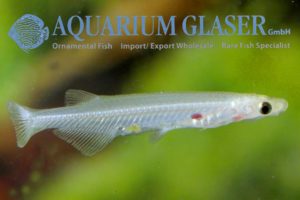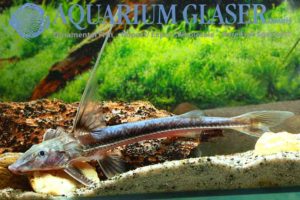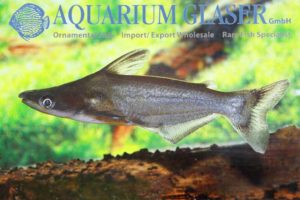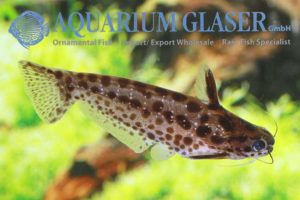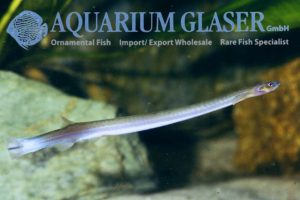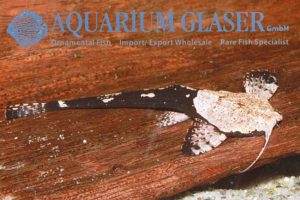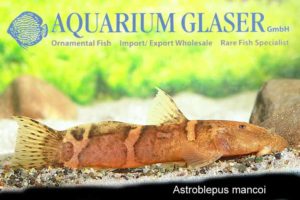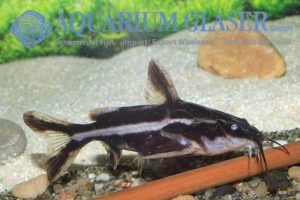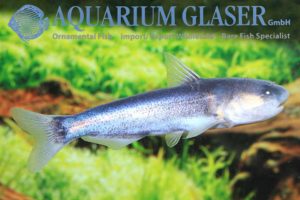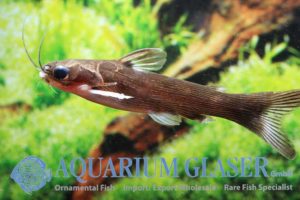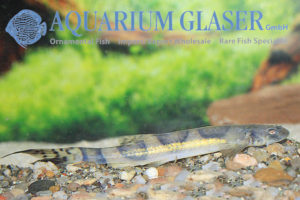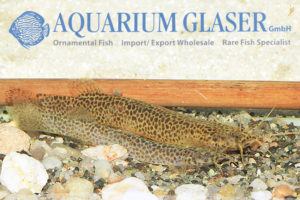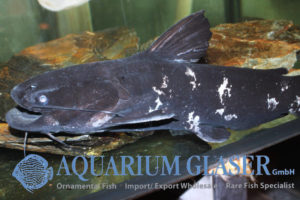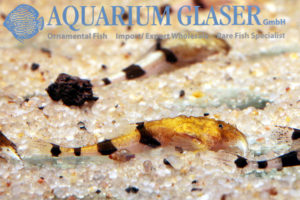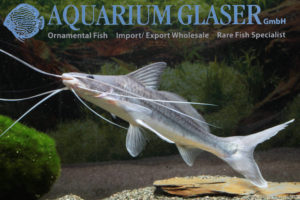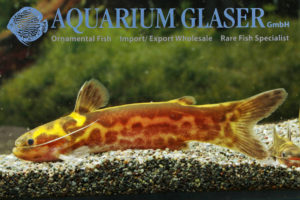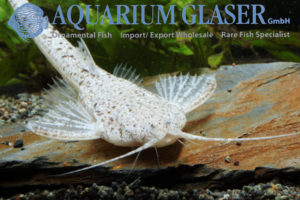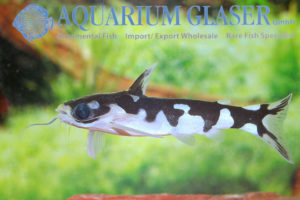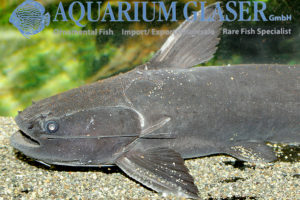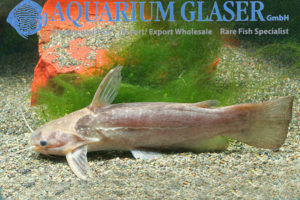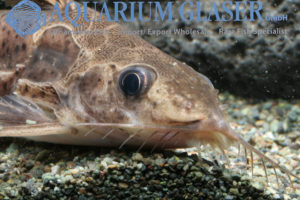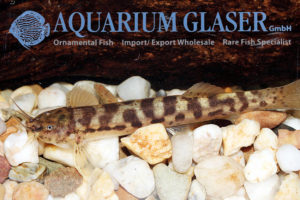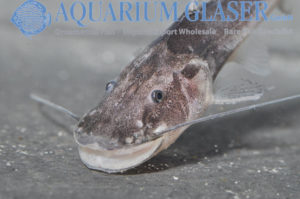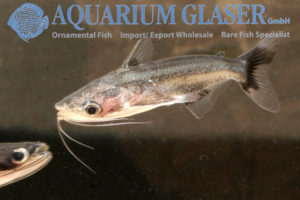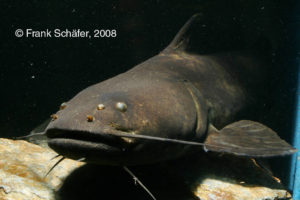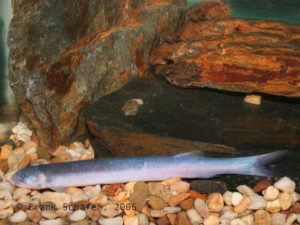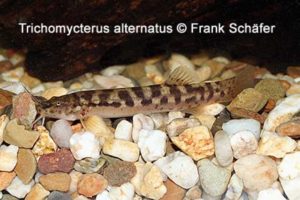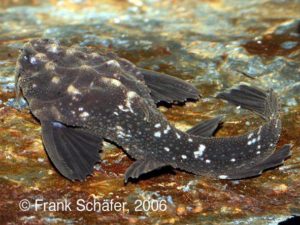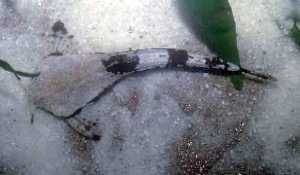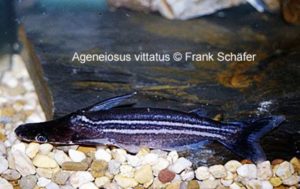Currently we received the cute freeswimming dwarf glass cat Tridensimilis brevis from Peru. The fish attains a maximum length of 3 cm. It belongs to the notorious candiru relationship, but is no blood sucker at all. This tiny catfish is that translucent that it is possible to observe the way of the food from the […]
10c. Catfishes: remaining catfish from South America (132)
-
-
Leptodoras juruensis
Once more we were able to import the very rare, bizarre Leptodoras juruensis from Peru in a very limited quantity. For our customers: the fish has code 266065 on our stocklist. Please note that we exclusively supply the wholesale trade.
-
Ageneiosus cf. atronasus
For the first time ever we received now this interesting doplhin catfish from Peru. In contrast to many of its congeneers this species stays relatively small and reaches only 12 cm in total length. Thus it is suitable also for normal sized home aquaria. However, one should always keep in mind that these catfishes are […]
-
Trachelyichthys sp. Jutai
We currently received this cute driftwood catfish from Brazil. Initially we thought all fish of the import would belong to the same, highly variable coloured species; but in the meantime we found that in fact two species were involved, namely T. sp. “Jutai” and Auchenipterichthys punctatus. Most probably Trachelyichthys sp. “Jutai” becomes as big as […]
-
Plectrochilus erythrurus
We managed to import a few specimens of the exteme rarely imported, blood sucking Candiru-catfish species Plectrochilus erythrurus, which have currently a length of 12-15 cm, from Peru. For our customers: the fish have code 280754 on our stocklist. Please note that we exclusively supply the wholesale trade. Text & photos: Frank Schäfer
-
Pterobunocephalus depressus
This is by far the most attractive species of all banjo cats – and the rarest. We recently received the fish for the first time from Peru. It is also one of the most variably coloured species of banjo cat. Most specimens have a sharp black-and-white contrasting pattern, being white anterior and black posterior. But […]
-
Astroblepus from Peru imported!
The L-numbers or Loricariidae belong to the most popular species of catfish from South America. But even very experienced aquarists will hardly ever had the opportunity to see alive a specimen of the genus Astroblepus, although the family Astroblepidae, which includes the single genus Astroblepus, is the closest relative of the loricariids. Astroblepids are distinguished […]
-
Orinocodoras eigenmanni
The talking catfishes (Doradidae) are an interesting group of fishes in many ways. A lot of the species have a very contrasting pattern of dark and light elements, they can make sounds (that can be compared with a grumbling or gnarling) and their armour of bony plates often looks that bizarr that one might think […]
-
Cetopsis cf. parma
Code: 414712
-
Tatia strigata
Once more we were able to import a species new for for the hobby: Tatia strigata. This small species – maximum length reported is around 6 cm – has been discovered and described as late as 1995. The unique colour pattern that differs slightly individually makes the species unmistakable. As in all Tatia, males can […]
-
Pseudostegophilus nemurus
Code number: 285593 Photos: Frank Schäfer
-
Ituglanis cf. metae
Code number: 264302 photos: Frank Schäfer
-
Trachycorystes sp. WHITE SPOTS
The genus Trachycorystes currently comprises three described species. In the aquarium hobby so far only T. trachycorystes appeared. For this up to 45 cm long species, please see http://www.aquariumglaser.de/en/news/Trachycorystes_trachycorystes_en/ Recently we received a 25-30 cm long specimen from Peru with an unique coloration: white, irregular spots on both sides of the body! It is unknown […]
-
Ernstichthys megistus
For the first time we were able to import a very astonishing species of catfish, which was known until 1985 from 3 specimens only. At the first glimpse the small animals – they are hardly 2 cm long – remind one on the Asian catfishes of the genus Akysis. Actually they are relatives of the […]
-
Pinirampus sp. Paraguay
The catfish family Pimelodidae is restricted to South America. It is a quite diverse family. Although only about 90 species are known they could hardly be more contrasting. The smallest species (a still undescribed one from the Amazon river) becomes only 2.5 cm long, the largest (Brachyplatystoma filamentosum) becomes 2 metres long. Most species, however, […]
-
Tatia dunni
Once more we were able to be the first who imported this pretty driftwood cat. The identification of Tatia species is not that easy. Although there is a very recent revision of the genus available, the species concept used there reflects only few aspects of coloration. So currently fish of very different coloration are lumped […]
-
Pseudobunocephalus sp. White Peru
The genus Pseudobunocephalus has been erected quite recently (2008). It is distinguished from the other banjo cat genera by externally invisible characters of the teeth and bone structures. As aquarists are more interested in fish than in technical definitions of genera it may be mentioned that nevertheless there are some external features that allow to […]
-
Centromochlus sp. Ninja (= C. orca)
A small sensation reached us recently from Brazil. Already when the small (4-6 cm long) catfish were unpacked their brillant black-and-white-pattern was a real eyecatcher. The fish definetely belong to the genus Centromochlus, which currently comprises 11 species in South America. These fish are close relatives of the better known genus Tatia and belong (like […]
-
Phractocephalus hemiliopterus
At Aquarium Glaser not only small fish for private community tanks are stocked, but also real rarities for scientific institutions and large fish for public aquaria and zoos. A specimen for the latter category reached us now: a gigantic Phractocephalus hemiliopterus, more than 80 cm long. We stocked the fish for a Russian customer. The […]
-
Trachycorystes trachycorystes
This bizarre species has been described scientifically already in 1840. It is widely distributed in the whole Amazon basin. Nevertheless it becomes only rarely imported and so it is highly demanded by fans of predatory catfish who pay quite high prices for them. The species can attain a total length of about 45 cm. We […]
-
Trachelyopterus galeatus
Already in 1766 this species was described under the name Silurus galeatus by the founder of the zoological nomenclature, Carl von Linné. It is extremely widespread in South America. Today this fish is classified in the family Auchenipteridae, and within this family in the subfamily Auchenipterinae. The species in Auchenipterinae share a very special feature: […]
-
Opsodoras stuebelii
The Doradidae family contains around 90 species in about 35 genera. Thus they represent only a minority among the huge number of catfishes existing in South America. But all dordadid catfishes are really bizzarre and desirable creatures for catfish enthusiasts. There are dordaid catfishes that reach around one metre in length, but for Opsodoras stuebelii […]
-
Trichomycterus alternatus: In the shadow of the vampire
female Sometimes fishes have the same problems as human beings: one cannot choose his relatives! And so the good reputation of a small fish sometimes is destroyed due to the bad one of a cousin. The most by far feared species of fish in South America is the so-called candiru. In fact, the name candiru […]
-
Brachyplatystoma
The catfishes of the genus Brachyplatystoma are some of the most important foodfish in the basins of the Amazon, the Orinoco and the countries of the Guiana shield. Some of them may reach a length of 360 cm and a weight of 200 kg. Many thousand tons are landed each year, which led to local […]
-
Auchenipterus nigripinnis
For the first time ever we were able now to import a catfish from Argentina which is new for the hobby. It looks amazingly similar to the Asian shark, Pangasianodon hypophthalmus (a well known synonym of that species is Pangasius sutchi). The identification of the new fish wasn´t easy, but thanks to Ingo Seidel from […]
-
Glanidium melanopterum
(09.May 2008) A real strange fish was now imported by us from the south of Brasil. This fish belongs to the Glanidium family and shows a size of about 40cm, which is really big for such an fish. They look very calm, but during the night they start to eat….everything what they can get into their big […]
-
Pareiodon cf. microps
This pencil catfish, a relative of parasitic the urethra of humans entering catfishes, is very rarely traded. The affiliation to the genus Pareiodon is rather clear, the species classification however is yet not clarifyed. As predators they should not be socialized with to small fishes. Due to their rarity no reports about their maintenance in […]
-
Trichomycterus alternatus
One of the in the aquarium most easy to keep pencil catfishes is Trichomycterus alternatus. This species, originating from the Rio de Janeiro region, reaches an overall length of for 10cm and can be maintained in aquaria starting from 60cm length. These very shy fish, reminding in their appearance of our in Europe native Stone […]
-
Amaralia hypsiura
January 2001: At present we can offer Amaralia hypsiura for friends of the extraordinary . This rarely dealt catfish attains full growth with approx. 15 cm length. It originates from the Amzon and there it feeds mainly, as gastric examinations of freshly caught fishes documents, predominantly the spawn of other fish. Fortunately they are not […]
-
Bunocephalus sp. „Black/White“
The banjocat new imported from Peru immediately attract attention due to their interesting colouring in contrast to other species of the same relation circle. Therefore some animals are almost unicoloured white while other specimens mainly show some irregular black markings. The care of this species does not differ from that of other relatives of this […]
-
Pseudoplatystoma corruscans
The rarely traded largest shovelnose catfish Pseudoplatysoma corruscans originates from the Rio Sao Francisco in Brazil. This predator becomes quite large (approx. 180cm) and heavy (100 kg). They like to stay in groups and socialize well with rays, big charazins, cichlids or other catfishes. (Photo F. Schäfer, Text K. Diehl)
-
Ageneiosus vittatus
July 2002: For the first time we could import Ageneiosus vittatus from Peru. Slopehead catfish of the genus Ageneiosus are particularly noticeable by its strongly flattened head. These predators can reach an overall length of 30 cm. For the maintenance large basins are necessary. A dark bottom, some stones and bogwood should be brought in […]





